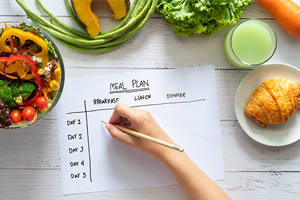How to manage portion control for a healthy weight?
Learn how to manage portion control for a healthy weight Discover practical tips and strategies to control your food portions and maintain a balanced diet for effective weight management
How to manage portion control for a healthy weight? Maintaining a balanced diet and controlling the size of your food portions is essential for achieving and sustaining a healthy weight. Portion control is not about restricting your food intake but about making informed choices to ensure you eat the right amount of nutrients without overindulging. In this article, we'll explore the importance of portion control, common challenges you might encounter, practical tips for success, and how it ties into meal planning. Additionally, we'll discuss healthy eating habits that contribute to sustainable weight management. Whether you're looking to shed a few pounds or simply want to adopt a more mindful approach to your meals, understanding the principles of portion control can make a significant difference in your journey toward better health.

Understanding the Importance of Portion Control
1. Portion Control Defined
Portion control refers to the practice of managing the quantity of food you eat during a meal or snack. It involves being mindful of the serving sizes you consume to maintain a healthy diet and control your calorie intake.
2. Impact on Weight Management
Effective portion control is crucial for achieving and maintaining a healthy weight. When you consume appropriate portion sizes, it helps you avoid overeating, which can lead to weight gain. By managing your portions, you can create a calorie deficit or maintain a balanced calorie intake, contributing to weight loss or maintenance.
3. Balancing Nutrient Intake
Portion control allows you to balance the nutrients you consume. It ensures that you're not only limiting calories but also getting a variety of essential nutrients from different food groups. This helps you meet your daily nutritional requirements while preventing excessive consumption of any particular nutrient.
4. Preventing Overindulgence
Large portions can lead to overindulgence, which is a common cause of weight gain. Overeating, even healthy foods, can lead to excess calorie intake. Portion control helps you enjoy your meals without the guilt of overindulging and supports sustainable weight management.
5. Avoiding Unhealthy Eating Habits
Failure to control portion sizes can result in unhealthy eating habits, such as mindless snacking, emotional eating, and consuming processed or high-calorie foods in excess. Learning portion control can steer you away from these detrimental behaviors and foster a healthier relationship with food.
6. Psychological Aspect
Portion control not only has physical benefits but also psychological ones. It helps you become more mindful of what you eat, promoting a greater awareness of your food choices and eating habits. This mindfulness can reduce stress and anxiety related to eating.
Benefits of Effective Portion Control
1. Weight Management
One of the most significant benefits of effective portion control is its positive impact on weight management. When you consistently consume appropriate portion sizes, you can maintain a healthy weight and avoid weight gain. It helps create a calorie deficit or maintain a balanced calorie intake, making it easier to reach your weight goals.
2. Preventing Overeating
Portion control is a powerful tool for preventing overeating. When you pay attention to serving sizes, it becomes easier to stop eating when you're satisfied, rather than continuing to eat until you're uncomfortably full. This reduces the risk of consuming excess calories and contributes to better appetite regulation.
3. Blood Sugar Control
Managing portion sizes is particularly beneficial for individuals with diabetes or those at risk of developing the condition. Controlling carbohydrate intake through portion control can help stabilize blood sugar levels, reducing the need for insulin or other medications and preventing sugar spikes and crashes.
4. Improved Digestion
Smaller, well-managed portions can lead to improved digestion. When you eat smaller meals, your digestive system can process food more efficiently, reducing the likelihood of indigestion, bloating, and discomfort. This can lead to a more comfortable post-meal experience.
5. Enhanced Nutrient Intake
Portion control ensures that you're not just limiting calories but also maximizing the nutrients you consume. By including a variety of food groups in appropriate portions, you can meet your daily nutritional requirements, ensuring you get essential vitamins, minerals, and other nutrients your body needs.
6. Controlled Food Costs
Effective portion control can also lead to cost savings. When you prepare and serve appropriate portions, you reduce food wastage and grocery expenses. Additionally, eating smaller portions can lead to leftovers, reducing the need to eat out or order takeout frequently.
7. Improved Psychological Well-being
Practicing portion control can have a positive impact on your mental well-being. It fosters a healthier relationship with food and promotes mindful eating. This can reduce anxiety and stress related to dieting and help you develop a more positive body image.
8. Long-term Health Benefits
Consistent portion control can lead to long-term health benefits, such as a reduced risk of chronic conditions like heart disease, high blood pressure, and obesity. By maintaining a healthy weight and balanced diet, you can enhance your overall health and well-being.
Common Challenges in Portion Control
1. Underestimating Serving Sizes
One of the most common challenges in portion control is underestimating serving sizes. Many people are unaware of what constitutes a standard serving, leading them to consume more calories than intended. This can result in overeating and hinder weight management efforts.
2. Influence of Supersized Portions
The prevalence of oversized portions in restaurants and fast-food chains has contributed to portion control challenges. People are often served much larger portions than they need, making it difficult to control calorie intake when dining out. Super-sized meals can distort our perception of what a "normal" portion should be.
3. Emotional Eating
Emotional eating is another significant obstacle in portion control. Many individuals turn to food as a way to cope with stress, sadness, or boredom. Emotional eating often leads to overconsumption of high-calorie foods, making it hard to manage portion sizes when emotions are driving food choices.
4. Lack of Mindful Eating
A lack of mindfulness while eating is a common challenge. When people eat without paying attention to their food, they may not realize when they're full. This can result in overeating because they haven't acknowledged their body's cues, such as feeling satisfied or no longer hungry.
5. Social Pressure and Peer Influence
Social situations and peer pressure can make portion control difficult. When you're at social gatherings or dining with friends, you might feel pressured to eat as much as those around you. This social influence can lead to overindulgence, even when you originally intended to control your portions.
6. Lack of Education
Many people lack proper education about portion control. They may not understand the concept of serving sizes or how to measure portions accurately. This lack of knowledge can hinder their ability to manage their food intake effectively.
7. Food Labels and Misleading Packaging
Misleading food labels and packaging can create challenges in portion control. Some products are marketed as single servings, but they contain multiple servings within one package. This can lead to confusion and unintended overconsumption.
8. Time Constraints
Busy schedules and time constraints can make it challenging to practice portion control. When people are rushed, they may grab convenient, pre-packaged, high-calorie foods, often neglecting portion size considerations. This can lead to overeating due to the lack of time for proper meal preparation and planning.
Practical Tips for Portion Control
Using Smaller Plates and Bowls
Opting for smaller plates and bowls is a practical way to control portion sizes. When you use smaller dinnerware, it visually tricks your brain into thinking that you're consuming more substantial portions. This can help prevent overeating by promoting a sense of satisfaction even with smaller amounts of food.
Measuring Portions with Everyday Objects
You don't always need measuring cups or scales to control portions. Everyday objects can be used as references. For instance, a deck of cards can approximate the size of a serving of meat, while a tennis ball can represent a portion of pasta. This method simplifies portion control when precise measurements aren't possible.
Eating Mindfully and Slowly
Mindful eating is a powerful technique for portion control. It involves paying close attention to the sensory aspects of eating, such as taste, texture, and aroma. Eating slowly and savoring each bite can enhance your awareness of fullness cues, making it easier to stop eating when you're satisfied rather than when the plate is empty. It also reduces the likelihood of overindulging.
Avoiding Emotional Eating
Emotional eating is a common challenge, but you can overcome it with strategies like keeping a food diary to identify emotional triggers. When you recognize emotional hunger, try alternative coping mechanisms like going for a walk, practicing deep breathing, or engaging in a hobby. By addressing emotional eating, you can better control your portions and make healthier food choices.
Portion Control and Meal Planning
1. Preparing Balanced Meals
Meal planning is a key component of effective portion control. When you plan your meals, you can ensure that each one includes a balanced combination of proteins, carbohydrates, and vegetables. This helps you maintain portion control while meeting your nutritional needs for a well-rounded diet.
2. Portion Control Containers
Portion control containers or divided plates are valuable tools for meal planning. These containers have compartments for different food groups, making it easier to portion your meals accurately. You can allocate the right amount of protein, grains, and vegetables, helping you stay on track with your portion control goals.
3. Pre-Packaging Snacks
Snacking can be a challenge when it comes to portion control. Pre-packaging snacks in appropriate serving sizes can help. By dividing larger snack items into single portions, you're less likely to overindulge. This is especially useful for snacks like nuts, trail mix, or chips.
4. Using Online Tools and Apps
Numerous online tools and mobile apps are available to assist with meal planning and portion control. These resources can help you calculate serving sizes, track your calorie intake, and create customized meal plans. They simplify the process of planning meals that align with your portion control objectives.
5. Batch Cooking and Freezing
Batch cooking and freezing portions is a time-efficient way to maintain portion control. You can prepare multiple servings of a particular dish and freeze them in individual portions. This approach reduces the temptation to consume extra food when you have a surplus of leftovers.
6. Portion Control Plates
Portion control plates are designed with portion guidelines, making it easy to measure your food. These plates typically have labeled sections for protein, carbohydrates, and vegetables. By filling each section as recommended, you can ensure balanced and controlled portions in every meal.
7. Planning Ahead for Special Occasions
When you have special occasions or dining out events on your calendar, planning ahead is crucial for portion control. You can check restaurant menus in advance, choose healthier options, and even request smaller portions or share meals with others to prevent overindulgence while still enjoying the experience.
Healthy Eating Habits for Sustainable Weight Management
1. Balanced Diet
Achieving sustainable weight management begins with a balanced diet. Focus on incorporating a variety of foods from all food groups, including fruits, vegetables, lean proteins, whole grains, and healthy fats. This balanced approach ensures you receive essential nutrients while controlling calorie intake.
2. Portion Control as a Lifestyle
Make portion control a part of your lifestyle, not just a temporary fix. Practice it consistently to maintain a healthy weight over time. Portion control should become second nature, helping you avoid overeating and make mindful food choices daily.
3. Mindful Eating
Mindful eating involves paying attention to the act of eating. It means savoring each bite, eating slowly, and enjoying your food without distractions. By eating mindfully, you're more likely to recognize when you're full and satisfied, reducing the risk of overeating.
4. Regular Meals and Snacks
Establish a routine of regular meals and snacks to keep your metabolism steady and curb excessive hunger. Skipping meals can lead to overeating later in the day. By spacing your meals and snacks throughout the day, you're more likely to maintain portion control.
5. Hydration
Staying well-hydrated is an often overlooked aspect of healthy eating for weight management. Sometimes, feelings of hunger are actually thirst in disguise. Drinking water before meals can help you eat less, as you'll feel more satisfied with smaller portions.
6. Cooking at Home
Cooking your meals at home gives you more control over portion sizes and ingredients. It allows you to prepare balanced, portion-controlled dishes. Additionally, you can experiment with healthier cooking methods to reduce excess calories and make your meals more nutritious.
7. Avoiding Highly Processed Foods
Highly processed foods often come in large, calorie-dense portions and can lead to overeating. Focus on whole, unprocessed foods whenever possible. These foods are typically more filling and provide essential nutrients, helping you maintain a healthy weight.
8. Seeking Professional Guidance
If you're struggling to manage your weight, consider seeking guidance from a registered dietitian or healthcare professional. They can provide personalized advice and strategies tailored to your specific needs and goals, helping you establish and maintain healthy eating habits for sustainable weight management.
FAQs: Addressing Common Questions About Portion Control
Q1: What is portion control, and why is it important for weight management?
A1: Portion control is the practice of managing the quantity of food you eat during a meal or snack. It's essential for weight management because it helps you control calorie intake, preventing overeating and promoting a healthy weight.
Q2: How can I prevent underestimating serving sizes?
A2: To prevent underestimating serving sizes, consider using smaller plates and bowls, and educate yourself about standard serving sizes for various foods. Practicing portion control can help improve your awareness of appropriate portions.
Q3: How does emotional eating affect portion control?
A3: Emotional eating can disrupt portion control by leading to overconsumption when you eat in response to emotions rather than hunger. Identifying emotional triggers and finding alternative coping mechanisms is essential to overcoming this challenge.
Q4: What are some practical tips for portion control?
A4: Practical tips for portion control include using smaller plates and bowls, measuring portions with everyday objects, eating mindfully and slowly, and avoiding emotional eating. These strategies help you manage your food portions effectively.
Q5: How can meal planning support portion control?
A5: Meal planning is a powerful tool for portion control as it allows you to prepare balanced meals, pre-package snacks, and allocate the right portion sizes in advance. It helps you stay on track with your portion control goals and maintain a healthy diet.
Q6: What role do portion control containers play in meal planning?
A6: Portion control containers are valuable tools for meal planning as they make it easier to portion your meals accurately. They have compartments for different food groups, simplifying the process of planning well-balanced, portion-controlled meals.
Q7: How can I avoid overindulgence in social situations?
A7: To avoid overindulgence in social situations, plan ahead, choose healthier options on the menu, and consider sharing meals or requesting smaller portions at restaurants. These strategies allow you to enjoy social events while maintaining portion control.
Q8: What are some healthy eating habits for sustainable weight management?
A8: Healthy eating habits for sustainable weight management include adopting a balanced diet, making portion control a lifestyle, practicing mindful eating, consuming regular meals and snacks, staying hydrated, cooking at home, and avoiding highly processed foods.
Q9: How can I incorporate portion control into my daily routine?
A9: To incorporate portion control into your daily routine, make it a habit by consistently using smaller plates, measuring portions, eating mindfully, and avoiding emotional eating. The more you practice, the easier it becomes to control your food portions naturally.
Q10: When should I seek professional guidance for weight management?
A10: Consider seeking professional guidance for weight management if you're struggling to achieve your goals or have specific dietary concerns. A registered dietitian or healthcare professional can provide personalized advice and support tailored to your needs and help you establish a sustainable approach to portion control and healthy eating.










